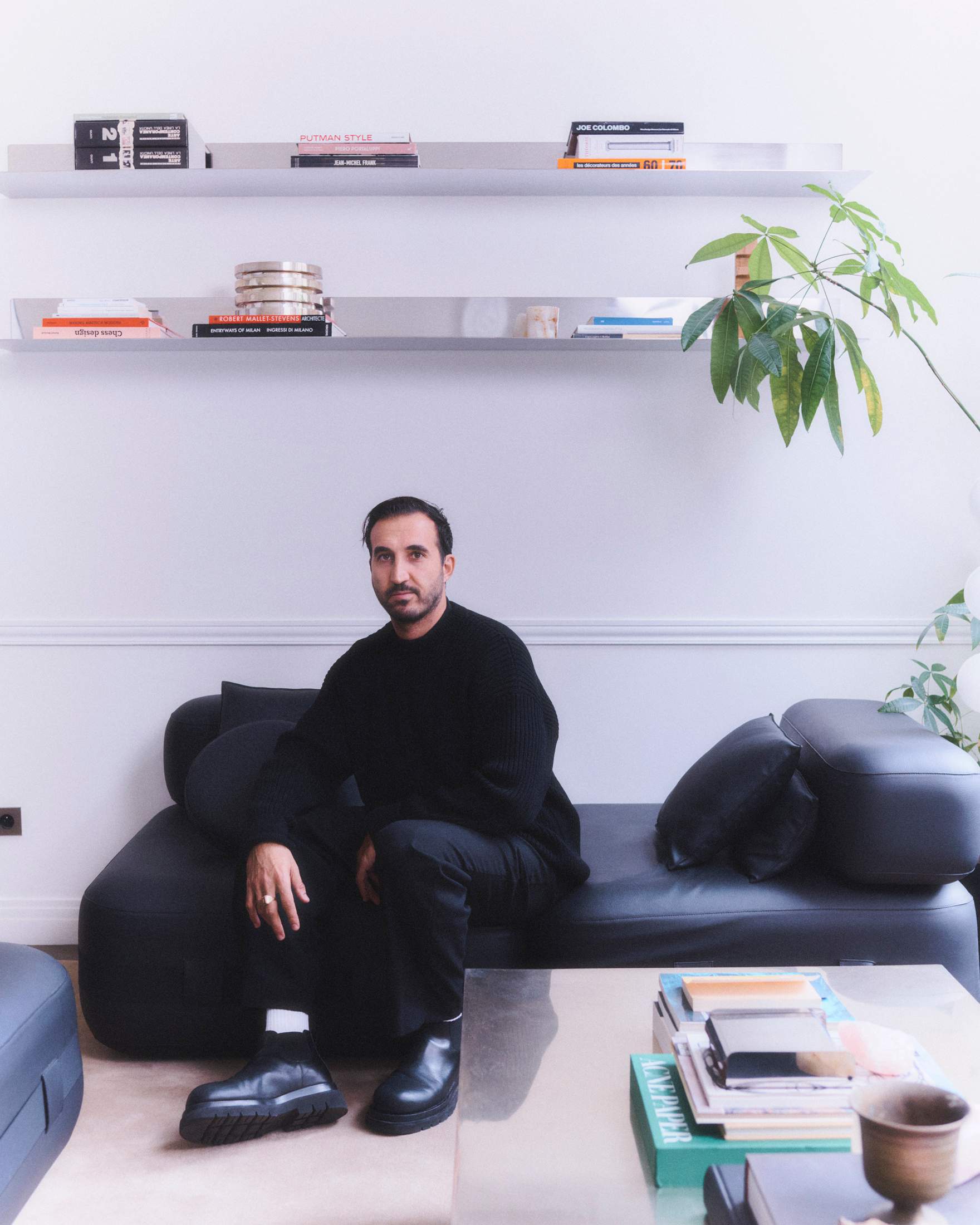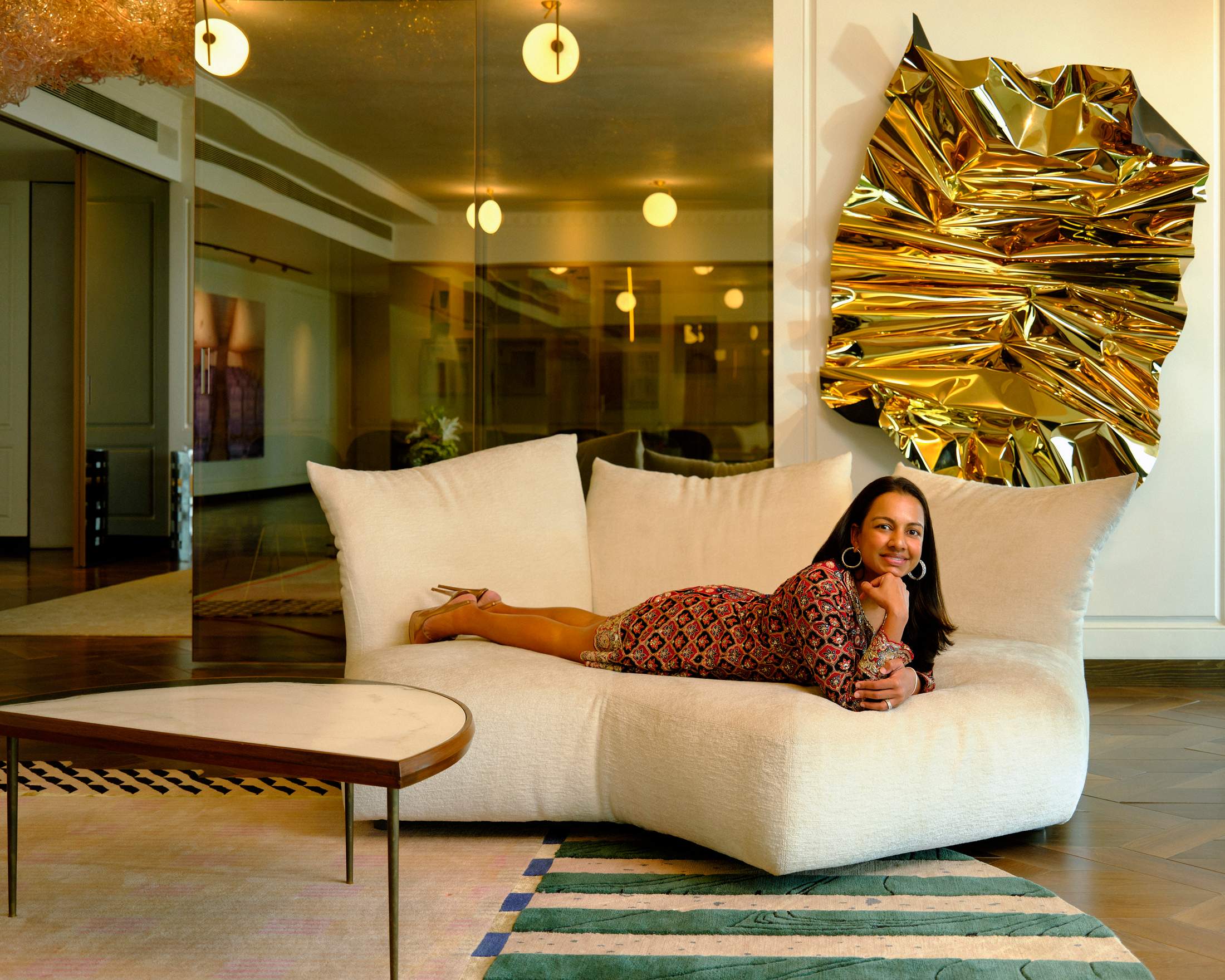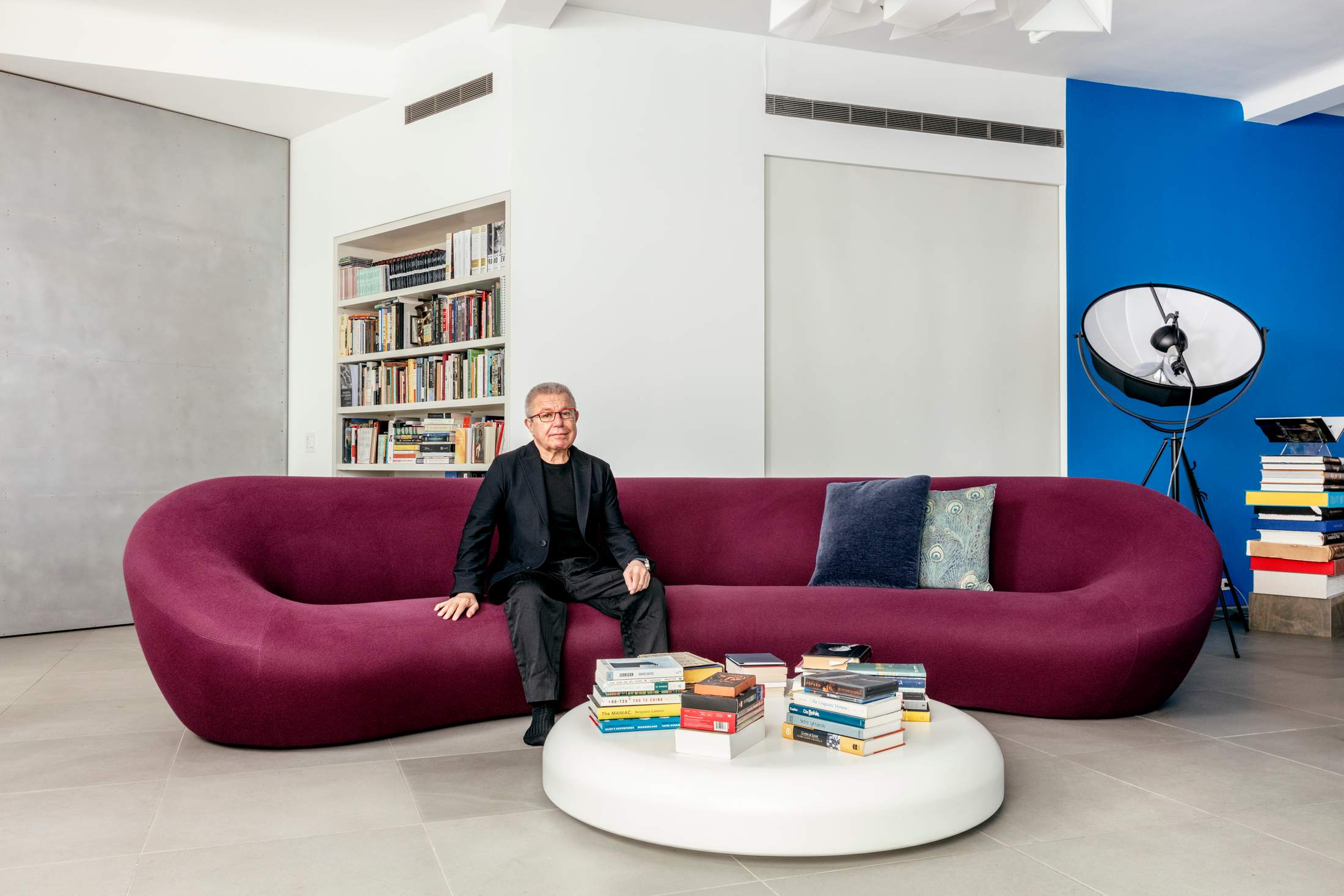Expo / Global
Best seat in the house
What can our settee tell us about our personalities, lifestyles and aspirations? We visit the homes of leading creatives to find out.

The sofa is – by many measures – the singular, most defining piece of furniture that one can own. Often the largest item in a living room, it can dictate everything from our behaviour to our selection of other pieces. Whether it’s a plush contemporary work or vintage leather number, our couches speak volumes about our personalities and lifestyles, providing somewhere to unwind, entertain and relax. Here, we visit the homes of leading creatives to hear about their settees. Get comfy and read on – just don’t forget to plump the cushions when you’re done.

Llisa Demetrios, curator, Petaluma
Eames sofaby Herman Miller
Llisa Demetrios has just returned home after giving the day’s last tour at the Eames Institute of Infinite Curiosity, the non-profit exhibition space in California’s Bay Area dedicated to the work of her grandparents, designers Charles and Ray Eames. “This is my place to pause,” says Demetrios, the institute’s chief curator, leaning back into the gently reclined black leather of the Eames sofa in her home. “It holds you but you also have to sink in a little bit; you don’t perch on a truly great sofa.” This sofa – the last project her grandparents worked on together – went into production in 1984, five years after Charles had died. Demetrios bought a pair almost 20 years ago, intending to pass them down to her own children. After all, Eames furniture was designed to withstand the test of time and Charles and Ray were always fascinated by how people lived with their work. “When I was growing up, they would send my mother a lot of prototypes,” adds Demetrios. “I do wonder now if they were just testing out what five young grandchildren could do with the furniture.”

Fien Muller & Hannes van Severen, designers, Ghent
Pillow sofa by BD Barcelona
“We like to live with our own pieces,” says Fien Muller, one half of Belgian design duo Muller van Severen, which she co-founded with Hannes van Severen in 2011. “We want to know how they behave in real life.” That includes the couch at their home in Ghent, which is in production with BD Barcelona. Launched at Salone del Mobile in April 2024, the Pillow Sofa was shipped directly from the showroom in Milan to take up residence in the couple’s living room. Modular and low-slung, it is upholstered in a bright, mint-green leather and informed by the best Italian mid-century designs. “Sofas are a difficult thing to design, because they have to be comfortable,” says Muller. To that end, the Pillow is passing its live-in test with flying colours. “I often fall asleep on it,” says Van Severen. “I wake up in the middle of the night thinking, ‘Where am I?’” On several occasions, the couple have even put up house guests for the night on the sofa. “Nobody has ever complained.”

Marcio Kogan, architect, São Paulo
Horizonte sofa by Minotti
For most, the ability to design one’s own dream sofa and have it put into production lies well beyond reach. Not so for Marcio Kogan, the Brazilian architect whose perch of choice is the Horizonte seating system, which he developed with Italian furniture company Minotti. “I’m an architect and in my studio we design everything for our projects,” says Kogan, who founded Studio mk27 in the 1970s. “One day, Minotti called us and asked where we bought the furniture for our projects. I said we design it.” It was a conversation that would change the course of work for both Studio mk27 and the furniture powerhouse; after the Minotti family visited Brazil, they invited Kogan to design for them. The partnership has been ongoing since Kogan’s first collection was released in 2018 and led to this sofa in 2022. “I like the proportion – that’s the main thing,” says Kogan “And I like the bouclé fabric.” He laughs, acknowledging that white sofas are a bold move. “But comfort is what’s most important.”

Wael al Awar, architect, Dubai
Armchair by Unknown
“I don’t know its name but I knew that it would be mine as soon as I saw it,” says Wael al Awar. The Dubai-based architect found this 1960s piece as a set of four in 1998 at a Sunday market in Beirut. “I was studying architecture and doing a module on informal economies, so looking for deals at the market was a weekend ritual,” he adds. The architect fixed up the full set, which was found in terrible condition, and brought it with him to Dubai. Today the four capacious seats sit in his family home with his wife and twin boys having their own individual perches to curl up on. “I hate today’s low-back sofas. You should feel cradled, which is why I also love the hammock-like Jangada chair by Jean Gillon.” Awar’s chair, with its inbuilt table, also forms his home office. “Tea sits on one side, with my laptop on the other. Hidden beneath these inlaid tables is a secret compartment to keep magazines and papers in order too. Designers back then challenged the idea of a sofa and I appreciate that.”

Nifemi Marcus-Bello, designer, Lagos
Äpplaryd sofa by Ikea
“Ikea has always been an interesting company and one I admire from afar,” says Nifemi Marcus-Bello. “I like its transparency around production and its design process.” The founder of Lagos-based Nmbello Studio is an ardent fan of the flat-pack specialist’s Äpplaryd sofa. “We didn’t have an Ikea in Lagos, so I had to go to great lengths to ship the sofa here from London.” Marcus-Bello’s work touches on narratives of African migration and identity, interweaving Nigerian artefacts with bold accents. He says that he never works on his sofa. “I associate it with rest so I can never get any work done,” he says. On weekends, the plush perch comes into its own. “The sofa plays a huge role within my space and family dynamic. It’s the only chair that we can all sit on at the same time.” He considered the limited natural light of the sofa’s surroundings, choosing a lighter fabric and a design that is raised off the floor to allow light to pass underneath. “The sofa is very considerate to our way of life.”

Tarini Jindal Handa, gallerist, Mumbai
Standard sofa by Edra
“The functionality and comfort are incredible,” says Tarini Jindal Handa about her favourite piece of furniture. As the founder of Aequo, India’s first collectable-design gallery, Handa knows a thing or two about good seating. What helped the Standard sofa – designed by Francesco Binfaré for Italian furniture company Edra – win her over was its impressive adaptability. “Sofas should be comfortable,” she tells monocle from her home in Mumbai. “That is their most important attribute.” The couch’s mouldable backs and sides, made using Edra’s Smart Cushion and Gellyfoam technology, make it an extremely versatile piece, which can either be set upright for comfortable chats with friends or turned into a daybed for lounging. “It’s one of those wide, white, fluffy sofas,” says Handa. Having owned it for more than 10 years, it has become integral to her home – the pièce maîtresse of the living room. Handa adds that the sofa has almost become part of the family, occupying pride of place.

Malika Favre, illustrator, Barcelona
Quilton sofa by Hay
“There are as many definitions of a good sofa as there are people,” says Malika Favre. The French illustrator’s choice comes in the shape of an electric-blue Quilton model by designer Doshi Levien for Danish furniture firm Hay. “Blue is my favourite colour. You can find pieces of it throughout my home.” It is also common in Favre’s work, such as her recent cover illustration for The New Yorker and re-edition of the 2017 Montreux Jazz festival poster. Before purchasing the Quilton model in 2023, Favre, who is based in Barcelona, had kept a mid-century couch through every move. It was nicknamed “the rock” because it was beautiful but not particularly comfy. Favre enjoys curling up in the evenings on her new (and cosier) Quilton but aesthetics remain key. “I need to be surrounded by beautiful things,” she says. “A good sofa should be comfortable but not at the cost of being gorgeous,” says Favre. “It needs to be elegant but also cosy and generous.”

Grant Wilkinson & Teresa Rivera, designers, London
Peonia sofa by SCP
Grant Wilkinson and Teresa Rivera opened their design and manufacturing studio in 2020, the year that their son was born, so it was only natural that young family dynamics would influence their work. “We bake purpose into our designs,” says Rivera, sitting on the mohair cord sofa, which they created for London-based design brand scp. “It’s ridiculous to have something in the home that you can’t use. With a four-year-old around, it has to be sturdy and scrubbable.” The couple are content with their elegant sofa being taken over by a preschooler. “We’re have-dinner-on-the-sofa people,” adds Wilkinson. “It’s why we made the Peonia so deep, so that we can all fit comfortably.” The couple met while studying fine art. Despite having since moved into furniture design, they still think like artists. “As soon as we put pen to paper and start sketching, we’re talking about it the same way we used to talk about sculpture back at school,” says Wilkinson.

Daniel Libeskind, architect, New York
La Maquette sofa by Louis Vuitton
“It was an impulse buy,” says Daniel Libeskind. The architect purchased his couch at Louis Vuitton’s 2014 Design Miami showcase, for which the French fashion house put the unrealised La Maquette collection by Pierre Paulin – including this sofa – into production. “I bought it without considering its size or scale, or the complexity of getting it up a building in New York.” But once it was placed in Libeskind’s home, its impact was immediate. “It’s the largest object that I have and has an unusual red-purple colour and an unexpected form that was clearly drawn by hand. That allows me to get away from the rectilinear modernist look that’s very prevalent in my house.” Today, it sits alongside the complementary white disc that is the La Maquette coffee table. “What makes a great sofa is not only comfort but what it looks like when you’re not sitting on it,” says Libeskind. “It’s about the views you get of it from different angles – looking down on it, looking across the room. I see La Maquette as a sculpture.”

Ingegerd Råman, designer, Stockholm
VVP02 sofa by Verk
Ingegerd Råman no longer owns a sofa. And that should not come as a surprise: the octogenarian designer never stops moving – or working. When monocle talks to her, she has just left Skåne, where she has run her namesake studio since 1967, to visit Nice via Stockholm. But when pressed on where we would find her if she were to take a perch, she says it would likely be in the studio of Verk, a Swedish furniture firm that she recently designed a textile for, which now upholsters its vvp02 sofa.“The company is built on the idea that we have nice wool in Sweden and we should be using it in our homes,” says Råman, best known for her glass and ceramic work. “They approached me to make a wool textile and I developed something that is mostly grey, because sheep are mostly grey,” she says. Should she ever purchase a new couch, she would finish it in the textile too. “I can’t do anything that I can’t have myself. I couldn’t make something that I couldn’t have around for 10, 20 or 30 years.”

Joris Poggioli, designer, Paris
Patrick leather sofa by Joris Poggioli
There’s a personal story behind the name of Joris Poggioli’s sofa. “Patrick is a member of the team who has helped us develop everything that we draw, in particular this sofa,” says the French-Italian designer. “Once we had it, after almost 20 prototypes, I thought that the least he deserved was to have it named after him.” Finished in black leather, it was built to be flexible and adapt to its owner’s everyday life. “I love hosting guests and enjoy lying down,” adds Poggioli. “I adore watching movies and having the option of accommodating friends who stay over.” Sleek and elegant, Patrick (the sofa, not the person) can be turned around in different ways and even endure dinner-party spills. “I’m not a big fan of colour, so black was perfect.” For Poggioli, the ideal sofa is not only a pile of pillows that you can sink into but an expression of taste. “Some people are obsessed with comfort. My vision is that you must please your eyes first, because comfort for the eyes is comfort for the brain.”

Farshid Moussavi, architect, London
Osaka sofa by La Cividina
“My living room is tall and long so I can choose pieces that wouldn’t work in a smaller space,” says Farshid Moussavi. The Iranian-born British architect’s environment calls for a sofa that can match it – and her five-metre-long version of the customisable Osaka sofa does just that. “It has metal brackets on the base, so you can shape and curve it. I was interested in this idea that I could change the look of the piece over time.” Moussavi spends much of her working day sitting down, so her spare time is spent away from the sofa. “I associate it with having company rather than relaxing alone,” she says, explaining that the sofa would be put to good use when she held birthday parties for her daughter, who grew up in the flat. The monochrome colour palette allows for some personalisation too, with Moussavi making a custom pillow inspired by one of her daughter’s drawings. And while comfort is important, the architect says it’s also critical that a sofa adds to the character of one’s home. “It’s a sculptural piece.”


